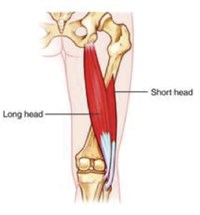

If you are suffering from knee pain, you are not alone - it is a very common complaint. A postural example to share that I often see in practice is where patients have an X leg pattern (below images) ‘knocked knees’. This can be in one or both knees, the example below is showing the right knee.
When this happens the pattern seen in the soft tissue is as follows:
The L image below shows the right side of the pelvis being lower than the left which we call a right tilt of the pelvis. The alignment of the right knee is being compromised, creating a strain on the inside of the knee. The left hip is higher changing the weight distribution into both legs. Instead of the weight being even through the centre of both legs, the right leg becomes a stabiliser with the line of force moving to the outer edge. The weight distribution into the left leg will be less and the line of force will be to the inside of the leg. Often clients are aware of feeling out of balance when they walk and be experiencing lower back pain.


So whats happening in the soft tissue when this happens?
The left femur (thigh bone) is held deeply into the hip socket by tight Gluteus Medius and the anterior Adductor muscles. The inner arch of the foot can also lift. In the Anatomy Trains lines, we are looking at tightness in the Deep Front Line below the pelvis.
On the right side the deeper muscles underneath the Glutes tighten, Gamelli's and Quadratus Femoris, plus the lateral hamstring - Short Head of the Bicep Femoris (SHBF) and Vastus Lateralis tighten. Over time a fascial adhesion builds between the femur and the SHBF which pulls the knee inward and we experience pain on the inside of the knee and/or underneath the Patellar. Beneath the knee the foot balance is altered dropping the inner arch because the Peroneal’s tighten on the outside of the Fibula reducing ankle mobility and unbalance the calf and Soleus. This is the Anatomy Trains Lateral Line.
When this happens we have no option other than to move out of alignment putting our right knee, ankle, hips and spine under strain. Often we are told to strengthen our quads to support our knee but if this imbalance is not corrected, no amount of quad strength will help.
Above the pelvis the compensation pattern continues. The left side/waist becomes very tight superficially beacause Quadratus Lumborum and the diaphragm become restricted. The right side of the ribcage becomes restricted and the right Psoas and spinal muscles tighten to stabilise you. This pelvis imbalance is often the primary cause of lower back L4 & L5 spinal problems.
The shoulders and neck become compromised too because superficial tightness of the ribcage restricts shoulder movement which tightens our Trapezius and Pectoral muscles and a tight Psoas pulls the neck forward and down creating problems in the C7 Vertebrae area. Standing tall and upright becomes increasingly more difficult.
What can help correct knocked knees reducing knee pain?
Orthotics can help lift the inner arch of the foot but if used for long period of time also weaken the foot structure. Stretching can help release tight areas and strengthening exercises will assist; but many people do not experience lasting change until the pattern is addressed.
KMI Structural Integration can alleviate knee pain and its compensations felt throughout the body. In this example lengthening the stabilising R Lateral Line and releasing the Left Deep Front Line through hands on techniques and movement will bring the pelvis back into horizontal balance and balancing the weight distribution taking strain away from the affected joints.
What makes KMI different is the approach of fascial release whilst focusing on whole body alignment which creates lasting change. To find out more, have a free consultation or to experience KMI Structural Integration, please do contact Angela Donovan of Structural Balance via telephone 07950 028 016 or email info@structuralbalance.co.uk.